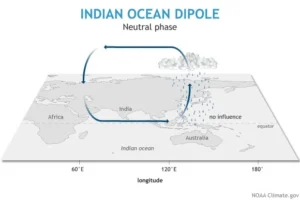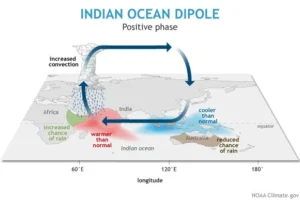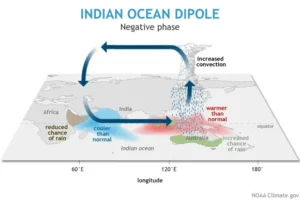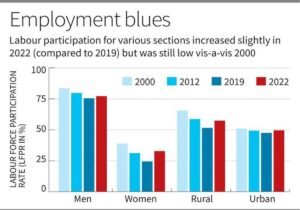GS Paper 1
Indian Ocean Dipole (IOD)
- News: The World Meteorological Organisation (WMO) in its Global Seasonal Climate Update for March-April-May 2024 has reported that the Indian Ocean Dipole (IOD) index is predicted to stay positive but is anticipated to return to near normal.
- Analysis:
- The Indian Ocean Dipole (IOD) refers to the swing in sea-surface temperatures from warm to cool and vice-versa between the eastern and the western parts of the Indian Ocean to the South of Sri Lanka.
- The IOD occurs in the relatively smaller area of the Indian Ocean (than the El Nino in the Pacific Ocean) between the Indonesian and Malaysian coastline in the east and the African coastline near Somalia in the west.
- This east-west contrast in ocean conditions (a “dipole”) alters the wind, temperature, and rainfall patterns in the region.
- IOD events usually originate in the months of April and May, however, these events occur irregularly and vary in strength and duration.
- The IOD is an ocean-atmosphere interaction very similar to the El Nino fluctuations in the Pacific Ocean. Therefore, sometimes referred to as the “Indian Nino”.
- It is, however, a much weaker system than El Nino, and thus has relatively limited impacts.
- IOD cycles through phases referred to as “positive”, “neutral” and “negative”.
- Neutral Phase of the IOD:
- A neutral phase would mean sea temperatures were close to average across the Indian Ocean.

- Positive Phase of the IOD:

- IOD is said to be positive when the western side of the Indian Ocean, near the Somalia coast, develops warmer-than-normal conditions than the eastern Indian Ocean near the Indonesian and Malaysian coastlines.
- In this phase, Indonesia and Australia tend to be drier than normal, which increases the chances of bushfires, while eastern Africa and India tend to be wetter than normal, increasing the likelihood of floods.
- The positive IOD event is known to help the South-West monsoon. A positive IOD leads to greater monsoon rainfall and more active (above normal rainfall) monsoon days while negative IOD leads to less rainfall and more monsoon break days (no rainfall).
- The 2019 was one of the strongest positive IOD events on record. It was developed in May 2019, and drove the India monsoon to excess and extended it into October.
- During an early IOD, the combined effect of Arabian sea evaporation and stronger cross equatorial flow — winds blowing from the southern tropics to the north across the equator — play an important role in enhancing the monsoon activity over the Indian subcontinent.
- A positive IOD does have the potential to offset the impacts of El Nino (associated with decrease in rainfall) to a small measure in neighbouring areas, and it has, at least once in the past (1997), delivered admirably on this potential.
- Further, it has been found that during a positive IOD and an El Nino event, the monsoon rainfall over India is likely to be above normal.
- In contrast, during a negative IOD and an El Nino event, the monsoon rainfall over India is likely to be below normal.
- Negative Phase of the IOD
- During the negative phase of the Indian Ocean Dipole, the western side of the Indian Ocean, near the Somalia coast, develops cooler-than-normal conditions than the eastern Indian Ocean near the Indonesian and Malaysian coastlines.
- Indonesia and Australia tend to be wetter than normal, while eastern Africa and India tend to be drier than normal.

-
Connection between ENSO and IOD
- A positive IOD event is often seen developing at times of an El Nino, while a negative IOD is sometimes associated with La Nina.
- During El Nino, the Pacific side of Indonesia is cooler than normal because of which the Indian Ocean side also gets cooler. That helps the development of a positive IOD.
- Nevertheless, it’s possible to have an extreme IOD event in the absence of El Nino or La Nina.
-
IOD and Climate Change
- The effects of the dipole could get worse because of climate change. A recent study argues that extreme positive IOD events will occur almost three times as often in the 21stcentury relative to the 20th
- The countries in the west of the Indian Ocean, so on the African coast, are going to see much, much more flooding and heavy rainfall relating to these events.
- On the other hand, in the east of the Indian Ocean, islands on the west side of Indonesia are going to see a greater chance of drought and reduced rainfall.
Monuments of National Importance (MNI)
- News: The Archaeological Survey of India (ASI) recently decided to delist 18 protected monuments as they have ceased to be of “national importance”.
- Archaeological Survey of India (ASI): It is the premier organization for the archaeological researches and protection of the cultural heritage of the nation.
- Ministry: Ministry of Culture.
- Foundation: Archaeological Survey of India was founded in 1861 by Alexander Cunningham, the first Director-General of ASI, often called the father of Indian archaeology.
- Functions:
- Maintenance of ancient monuments and archaeological sites and remains of national importance
- Regulation of all archaeological activities in the country as per the provisions of the Ancient Monuments and Archaeological Sites and Remains Act, 1958
- It also regulates Antiquities and Art Treasure Act, 1972
- Architectural survey of monuments
- Training in Archaeology
- Archaeological expeditions outside India
- Conducting archaeological explorations and excavations
- Chemical preservation of monuments and antiquarian remains
- Epigraphical and numismatic studies
- Setting up and re-organization of Site Museums
- Declaration of Monuments and Sites as of National Importance (MNI):
-
- The declaration of monuments and sites as of national importance is done under section 4 of the Ancient Monuments and Archaeological Sites and Remain Act, 1958.
- Central Government issues a notification to declare any ancient monument which archaeologically, historically or architecturally qualifies to be of national importance .
- After considering the views/objections received within the stipulated period, the Central Government may declare the ancient monument to be of national importance by publishing a notification in the official gazette.
- Once a monument or a site is declared to be MNI, their protection and upkeep is the responsibility of the Archaeological Survey of India.
- Construction activities are banned around 100 metres within the sites where the monuments are located.
- Also, prior permission is required for any repairs or modifications within 200 meters.
- Delisting of Monuments:
- The ASI has the power to delist monuments it deems to “have ceased to be of national importance” under Section 35 of the Act.
- Delisting of a monument effectively means it will no longer be conserved, protected, and maintained by the ASI.
- Once the monument is delisted, activities related to construction and urbanisation in the area can be carried out in a regular manner.
- Once a monument is delisted, the ASI becomes no longer responsible for protecting these monuments.
- The maximum ‘lost’ monuments are from Uttar Pradesh.
GS Paper 2
National Disaster Response Fund (NDRF)
- News: The Karnataka Government has moved the Supreme Court seeking a direction to the Centre to release financial assistance from the National Disaster Response Fund (NDRF) to the state for drought management.
- Introduction to NDRF: The National Disaster Response Fund (NDRF) is a centrally managed fund designed to address emergency relief, disaster response, and rehabilitation expenses during disasters.
- Established under Section 46 of the Disaster Management Act, 2005, it serves as a critical resource in times of calamity.
- It is to be noted that under the 2005 Disaster Management Act, there is no definition of disasters.
- It can include any event arising from natural or man-made causes that can severely disrupt life for people, going beyond their coping capacity.
- Scope and Coverage:
- NDRF covers a wide range of natural calamities, including cyclones, droughts, earthquakes, fires, floods, tsunamis, hailstorms, landslides, avalanches, cloud bursts, and pest attacks recognized as severe by the Government of India.
- It also covers man-made disasters such as terrorist attacks, chemical or biological disasters, or nuclear disasters as notified by the Central Government.
- It steps in to provide immediate relief when a State’s Disaster Response Fund (SDRF) lacks sufficient resources to manage the situation effectively.
- Funding:
- The fund is placed within the “Public Account” of the Government of India under “reserve funds not bearing interest,” ensuring its availability for disaster response.
- NDRF is financed through levies on specific items subject to excise and customs duties, which are approved annually through the Finance Bill.
- Utilization and Decision-Making: States seeking NDRF assistance must submit detailed memorandums outlining damage assessments and fund requirements.
- The Central Government evaluates these requests and allocates additional funds accordingly.
- Purpose and Limitations:
- NDRF provides immediate relief and is not intended as compensation for property or crop losses.
- It does not cover disaster preparedness, restoration, reconstruction, or mitigation efforts, which are funded through separate schemes such as the National Disaster Mitigation Fund (NDMF) and others.
- Accountability and Oversight:
- NDRF accounts undergo annual audits conducted by the Comptroller and Auditor General (CAG), ensuring transparency and accountability in fund utilization.
- Since the NDRF is placed in the public accounts, the government does not require parliamentary approval to take money out of this fund.
- Supplementary Funding and Administration: In cases where NDRF funds are insufficient, additional requirements are met through general budgetary resources.
- The National Executive Committee (NEC) of the National Disaster Management Authority (NDMA) oversees expenditure decisions.
Ex-parte Injunction
- News: The Supreme Court has expressed concerns regarding the issuance of pre-trial injunctions by courts, especially in cases involving the publication of articles. According to the court, such injunctions could significantly impact both the author’s right to freedom of speech and the public’s right to access information.
- Ex-parte Injunction: It is a court order that is issued without hearing from the other party involved in the case. It is also known as a temporary restraining order.
- Ex-parte Injunction is only granted in emergency situations where there is a risk of irreparable harm if immediate action is not taken.
- Injunction:
- An injunction is a remedy granted by the court that prohibits the commission of a wrong threatened or the continuance of a wrongful course of action already begun.
- Injunctions can be granted in a variety of situations, such as in cases of intellectual property infringement, breach of contract, or defamation.
- Injunctions are a discretionary remedy and the court will consider various factors before deciding whether to grant an injunction.
- If a party fails to comply with an injunction granted by a court, then the party could face criminal or civil penalties or contempt of court.
- The law of injunctions is covered explicitly under various Relief Acts and is implemented in accordance with the Civil Procedure Code.
- Types of Injunction:
- Preliminary Injunction: A preliminary injunction, which is also known as an ad-interim injunction, is assigned to a plaintiff prior to a trial.
- It preserves the subject matter in its existing condition to prevent any dissolution of the plaintiff’s rights, and thereby render him/her the possibility of immediate relief.
- Preventive Injunctions: A preventive injunction is an adjudication that forces an individual to abstain from doing an action that is preventive, prohibitive or negative.
- The injunction intends to prevent a threatened injury, preserve the status quo, and reserve the continued commission of an ongoing wrong.
- Mandatory Injunction: A mandatory injunction directs the defendant to perform an act.
- For example, if a court orders the removal of a building or structure due to misplaced construction, then it fits the description of a mandatory injunction.
- Temporary Restraining Order: A temporary restraining order is just what its name suggests, as the same is valid until the period of restraining order draws to a closure.
- The court grants it to preserve the status quo of the subject of the controversy until the hearing of an application for a temporary injunction.
- Through it, it also seeks to prevent any instance of unnecessary and irreparable injury.
- Permanent Injunction: At the time of final judgement issues the permanent injunction for granting a final relief to the applicant.
- These injunctions remain constant if the conditions that produced them are permanent.
National Organ and Tissue Transplant Organization (NOTTO)
- News: National Organ and Tissue Transplant Organization (NOTTO) has expressed concern over some States not compiling living and deceased donors’ data.
- Definition: National Organ and Tissue Transplant Organization (NOTTO) is a National level organization set up under Directorate General of Health Services, Ministry of Health and Family Welfare, Government of India.
- Aim: National Network division of NOTTO functions as apex centre for:
- All India activities of coordination and networking for procurement and distribution of Organs and Tissues and
- Registry of Organs and Tissues Donation and Transplantation in the country.
- Divisions: NOTTO has two divisions:
- National Human Organ and Tissue Removal and Storage Network: This has been mandated as per the Transplantation of Human Organs (Amendment) Act 2011.
- It is the nodal networking agency for Delhi and shall network for Procurement Allocation and Distribution of Organs and Tissues in Delhi.
- National Biomaterial Centre: The Transplantation of Human Organs (Amendment) Act 2011 has included the component of tissue donation and registration of tissue Banks.
- The main aim of establishing this centre is to fill up the gap between ‘Demand’ and ‘Supply’ as well as ‘Quality Assurance’ in the availability of various tissues.
- Functions of NOTTO :
- Network with similar regional and state level organizations.
- All registry data from States and Regions would be compiled and published.
- Creating awareness, promotion of organ donation and transplantation activities.
- Co-ordination from procurement of organs and tissues to transplantation when organ is allocated outside the region.
- Dissemination of information to all concerned organizations, hospitals and individuals.
- Monitoring of transplantation activities in the Regions and States and maintaining data-bank in this regard.
- To assist in data management for organ transplant surveillance & organ transplant and Organ Donor registry.
- Consultancy support on the legal and non-legal aspects of donation and transplantation.
- Coordinate and Organize trainings for various cadre of workers.
Strategic Litigation against Public Participation(SLAPP)
- News: The Supreme Court has issued a cautionary statement to courts regarding the rising trend of “SLAPP Suits” utilized by influential economic entities. These suits are employed against media personnel or members of civil society with the aim of impeding public access to vital information and participation in matters of public interest.
- The term “SLAPP suit” was coined by professors George W Pring and Penelope Canan from the University of Denver in the 1980’s.
- It is an umbrella term used to refer to litigation predominantly initiated by entities that wield immense economic power against members of the media or civil society, to prevent the public from knowing about or participating in important affairs in the public interest.
- In other words, it refers to lawsuits intended not to win the case but primarily to censor, intimidate, and silence critics by burdening them with the cost of a legal defense.
- For instance: An environmental group protests against a big corporation over pollution, and the big corporation sues the group in return for defamation.
UPSC News: Indian Laws & Tech: Digital Piracy, ETFs & More
Financing Agrochemical Reduction and Management Programme
- News: It is a new initiative led by UN Environment Programme (UNEP).
- Definition: It is a $379 million initiative to combat pollution from the use of pesticides and plastics in agriculture.
- Launched by: Ecuador, India, Kenya, Laos, Philippines, Uruguay, and Vietnam.
- Goal:
- The FARM Programme aims to support government regulations targeting the phase-out of Persistent Organic Pollutants (POPs)-containing agrochemicals and agri-plastics.
- It also promotes the adoption of better management standards in agriculture.
- Risks Posed by Chemicals in Agriculture:
- Chemical inputs like pesticides and agricultural plastics, while beneficial for food yields, pose significant risks to human health and the environment.
- Annually, approximately 11,000 people succumb to the toxic effects of pesticides, while chemical residues degrade ecosystems and soil health.
- Mismanaged agricultural plastics and highly hazardous pesticides contribute to the release of toxic Persistent Organic Pollutants (POPs) into the environment.
- These pollutants persist in the environment, contaminating air, water, and food, and contribute to health issues and ecosystem degradation.
- Despite the risks associated with chemical inputs, they are often cheaper than sustainable alternatives, providing farmers with little incentive to adopt better practices. The FARM programme seeks to address this challenge by strengthening banking, insurance, and investment criteria to improve the availability of effective pest control and sustainable production alternatives.
- The burning of agricultural plastics exacerbates air pollution, contributing to a global crisis that leads to one in nine deaths worldwide.
- By addressing the mismanagement of agricultural plastics, the FARM Programme aims to mitigate this aspect of the crisis.
- Key Features:
- Objectives and Impact:
- The five–year initiative is projected to prevent the release of over 51,000 tons of hazardous pesticides and 20,000 tons of plastic waste.
- Additionally, it aims to avoid 35,000 tons of carbon dioxide emissions and protect more than 3 million hectares of land from degradation.
- Collaborative Approach:
- The programme signifies a significant collaborative effort involving governments, financial institutions, farmers, and manufacturers.
- By fostering cooperation among these stakeholders, it aims to address agricultural pollution effectively.
- Economic Incentives and Challenges:
- Despite the risks associated with chemical inputs, they are often cheaper than sustainable alternatives, providing farmers with little incentive to adopt better practices.
- The programme seeks to address this challenge by strengthening banking, insurance, and investment criteria to improve the availability of effective pest control and sustainable production alternatives.
- Addressing Air Pollution Crisis:
- The burning of agricultural plastics exacerbates air pollution, contributing to a global crisis that leads to one in nine deaths worldwide.
- By addressing the mismanagement of agricultural plastics, the FARM Programme aims to mitigate this aspect of the crisis.
- Empowering Farmers with Sustainable Practices:
- The FARM Programme introduces a transformative model, empowering farmers by providing them with essential knowledge and resources.
- Through the programme, farmers are encouraged to transition from conventional practices to sustainable methods that not only protect human health and the environment but also enhance agricultural productivity.
GS Paper 3
Arsenic
- News: The National Green Tribunal has issued notices to some States and Union Territories for the presence of arsenic in groundwater.
- Arsenic:
- Arsenic is a naturally occurring, semimetallic element widely distributed in the Earth’s crust.
- Arsenic is found in water, air, and soil.
- Because it is an element, arsenic persists in the environment and does not deteriorate.
- Forms: There are two general forms of arsenic:
- Organic arsenic compounds contain carbon.
- Inorganic arsenic compounds do not contain carbon.
- Sources:
- The greatest threat to public health from arsenic originates from contaminated groundwater.
- Arsenic is used industrially as an alloying agent, as well as in the processing of glass, pigments, textiles, paper, metal adhesives, wood preservatives and ammunition.
- Arsenic is also used in the hide tanning process and, to a limited extent, in pesticides, feed additives and pharmaceuticals.
- People who smoke tobacco can also be exposed to the natural inorganic arsenic content of tobacco because tobacco plants can take up arsenic naturally present in the soil.
- Fish, shellfish, meat, poultry, dairy products and cereals can also be dietary sources of arsenic.
- Risks: All arsenic is toxic to humans and can affect people of any age or health status.
- Inorganic arsenic is a confirmed carcinogen and is the most significant chemical contaminant in drinking-water globally.
- Long-term exposure to arsenic from drinking-water and food can cause cancer and skin lesions.
- It has also been associated with cardiovascular disease and diabetes.
- Arsenic Contamination in Indian States: In India, the states of West Bengal, Jharkhand, Bihar, Uttar Pradesh, Assam, Manipur & Chhattisgarh are reported to be most affected by arsenic contamination of groundwater above the permissible level.
Sea Cucumber
- News: It has been found that Sea Cucumber might help in protecting the planet’s coral reefs.
- Sea Cucumbers:
- Sea cucumbers are part of a larger animal group called echinoderms, which also contains starfish and sea urchins.
- Their body shape is similar to a cucumber, but they have small tentacle-like tube feet that are used for locomotion and feeding.

- Sea cucumbers are found in all marine environments throughout the world, from shallow to deep-sea environments.
- Sea cucumbers are benthic, meaning they live on the ocean floor. However, their larvae are planktonic, meaning they float in the ocean with the currents.
- Sea cucumbers exhibit sexual and asexual reproduction.
- Unlike most terrestrial animals, sea cucumber eggs undergo external fertilization—females release eggs into the water that are fertilized when they come into contact with sperm that males have released.
- A sea cucumber can live for 5 to 10 years.
- Conservation Status: Their collection or trade is banned under Schedule I of the Wildlife Protection Act of 1972.
India Employment Report 2024
- News: The India Employment Report 2024 has been jointly released by the Institute for Human Development and International Labour Organisation.
- Institute for Human Development:
- The Institute for Human Development (IHD) was established in the year 1998 under the aegis of the Indian Society of Labour Economics (ISLE).
- It is a non-profit autonomous institution that aims to build a society that fosters and values an inclusive social, economic and political system that is free from poverty and deprivations.
- It undertakes research in the areas of labour and employment, livelihood, gender, health, education and other aspects of human development.
- India Employment Report:
- It is jointly prepared by the Institute for Human Development in collaboration with the International Labour Organization (ILO).
- It highlights the challenges of youth employment within India’s evolving economic, labor market, educational, and skills landscapes.
- India Employment Report has used the data analysis from the National Sample Surveys and the Periodic Labour Force Surveys between 2000 and 2022.
- Key Findings:
- Almost 82% of the workforce is engaged in the informal sector, and nearly 90% is informally employed.
- There has been an increase in female labor market participation rates since 2019, especially in rural areas.
- There has been also a gradual shift in the workforce from agricultural to non-farm sectors.
- A modest rise in the wages of casual laborers between 2012 and 2022 has been observed while real wages for regular workers have stagnated or declined.
- India is expected to have a migration rate of around 40% in 2030 and will have an urban population of around 607 million.

- Challenges of Youth Employment:
- India currently benefits from a sizable working-age population, positioning it within the potential demographic dividend zone for the next decade.
- India is approaching a critical juncture as the proportion of youth in the population is projected to decrease from 27% in 2021 to 23% by 2036.
- Annually, India sees the addition of 7–8 million youths to its labor force, representing a significant potential for leveraging the demographic dividend.
- Despite this potential, youth participation in the labor market has historically been lower compared to adults, mainly due to increased engagement in educational pursuits.
- Over the period from 2000 to 2019, youth unemployment surged nearly threefold, reaching 17.5% in 2019 before declining to 12.1% in 2022.
- Following the COVID-19 lockdowns, indicators in the youth labor market rebounded swiftly, reflecting signs of recovery.
- However, this recovery was accompanied by an increase in labor force and workforce additions, primarily in lower-quality employment sectors, posing challenges regarding job quality.
- Way Forward:
- Promoting job creation;
- Improving employment quality;
- Addressing labour market inequalities;
- Strengthening skills and active labour market policies; and
- Bridging the knowledge deficits on labour market patterns and youth employment.
Facts for Prelims
Moyar Valley
- Location: It extends from Gudalur through the core area of Mudumalai Tiger Reserve (Tamil Nadu).
- The valley is an important biome in the Nilgiri Biosphere Reserve, sheltering several vital species like tiger & elephant & the critically endangered Gyps
- A biome is an area classified according to the species that live in that
- Flora and Fauna:
- Moyar Valley is the home of critically endangered Gyps
- It is the only region in peninsular India which has the biggest nesting colony of Gyps vultures in the wild.





